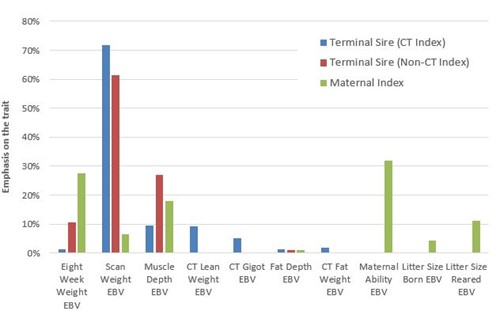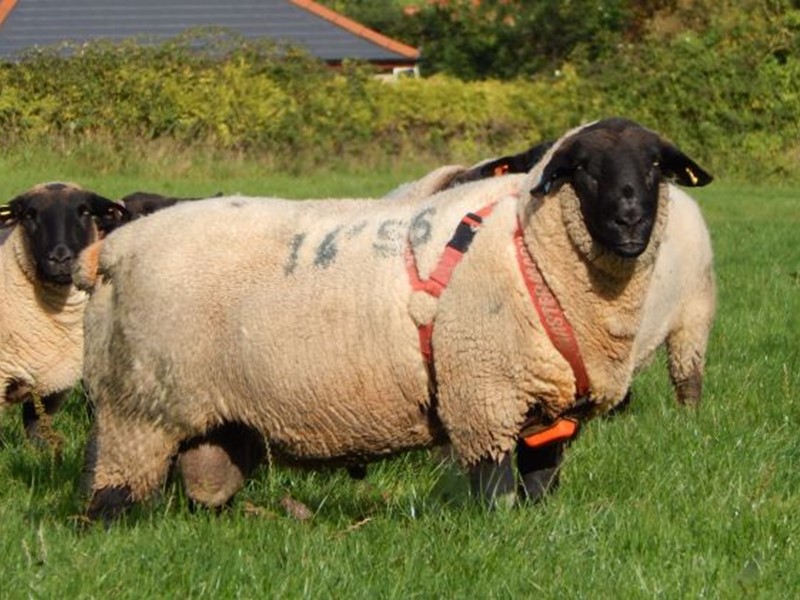Terminal Sire Index
Breeding Indexes for Terminal Sires - Updated January 2021
In 2019 Signet introduced major changes to the genetic evaluation of Terminal Sire breeds. The way we analyse carcase traits like Muscle Depth, Fat Depth, Lean Weight and Fat Weight has changed to express these traits on a liveweight adjusted, rather than an age adjusted basis.
The new approach is more accurate and commercially focussed, enabling producers to select rams whose progeny have superior carcase attributes as they approach slaughter weight.
It also meant we had to update the breeding indexes we use for our Terminal Sire breeds, taking into account the new trait relationships and feedback from breeders over recent years.
What type of breeding indexes are available?
There are three breeding indexes in use:
- Terminal Sire – For CT scanning breeds
- Terminal Sire – For non-CT scanning breeds
- Maternal breeding index – For all Terminal Sire breeds
The type of terminal sire index generated depends on whether the breeds is actively engaged in CT scanning.
How did we create the new indexes?
Signet/SRUC used a “desired gains” approach to optimise selection for those traits that breeders and commercial farmers deem to be of economic importance.
Index construction in the past was easier, as many of the traits of interest were positively correlated to each other, enhancing one trait would often increase another. In Signet’s new analysis, where carcase attributes are expressed independently from growth rate, a considered approach is required to enhance both growth and carcase attributes.
To determine the ideal index, a series of models were created shifting the balance of index weightings between growth (Scan Weight EBV), muscling across the loin (Muscle Depth EBV) and meat yield (CT Lean Weight EBV).
Too much emphasis on either trait, would tend to result in a loss of genetic gain in another. However, a set of index weightings have been found that enable high rates of genetic progress in all three traits.
So what are the index weightings in the Terminal Sire Index?
The raw weightings are shown below, but these mean little in isolation as traits have different heritability values and genetic correlations to each other.
Raw Index Weightings
|
Terminal Sire (CT Index) |
Terminal Sire (Non-CT Index) |
Maternal Index |
|
|
Eight Week Weight EBV |
0.1 |
0.9 |
2.8 |
|
Scan Weight EBV |
0.85 |
0.8 |
0.1 |
|
Muscle Depth EBV |
0.8 |
2.5 |
2 |
|
Fat Depth EBV |
0.5 |
0.5 |
0.5 |
|
Litter Size Born EBV |
0 |
0 |
14 |
|
Litter Size Reared EBV |
0 |
0 |
37 |
|
Maternal Ability EBV |
0 |
0 |
5 |
|
CT Lean Weight EBV |
4.5 |
0 |
0 |
|
CT Fat Weight EBV |
1 |
0 |
0 |
|
CT Gigot EBV |
0.1 |
0 |
0 |
A better way to compare them is to look at the relative emphasis placed on each trait

Emphasis on traits within breeding indexes.
|
Terminal Sire (CT Index) |
Terminal Sire (Non-CT Index) |
Maternal Index |
|
|
Eight Week Weight EBV |
1.3% |
10.6% |
27.6% |
|
Scan Weight EBV |
71.7% |
61.3% |
6.4% |
|
Muscle Depth EBV |
9.5% |
27.0% |
18.0% |
|
Fat Depth EBV |
1.2% |
1.1% |
0.9% |
|
Litter Size Born EBV |
|
|
4.2% |
|
Litter Size Reared EBV |
|
|
11.0% |
|
Maternal Ability EBV |
|
|
31.8% |
|
CT Lean Weight EBV |
9.2% |
|
|
|
CT Fat Weight EBV |
1.8% |
|
|
|
CT Gigot EBV |
5.2% |
|
|
Why not have more emphasis on Muscle Depth EBV?
Increasing the emphasis on muscle depth, will greatly reduce the genetic gain achievable in lamb growth rate. It should be remembered that growth rate tends to have a greater economic value to commercial producers than increased muscling across the loin at a fixed weight.
Why not have more emphasis on the CT Lean Weight EBV?
Increasing the emphasis on lean weight will also reduce the genetic gain achievable in lamb growth rate. It will also mean the sheep get leaner, much faster - which is something to be aware of when selecting rams with a high yield of meat in the carcase.
How were the weightings for Fat Depth EBV and Fat Weight EBV derived?
Firstly, we are aware that breeders don’t want to see leaner genetics rewarded at the expense of well-muscled, slightly fatter individuals. Recorded terminal sires, with superior growth and muscling are already helping to produce leaner commercial lambs – and this was taken into account when setting index weightings.
Secondly, when carcase traits are expressed on a weight adjusted basis, animals with a high yield of muscle in the carcase tend to have less fat. So the index doesn’t need to apply an additional reward for leanness.
In fact a small, positive weighting is now applied to both of the weight adjusted breeding values for fat to avoid the inadvertent selection of ultra-lean genetics in the quest for greater levels of muscling.
What is the Maternal Index?
The Dorset and Suffolk breeds have had a maternal index for many years and we believe it will be useful when selling rams to breed female replacements.
The index places a strong emphasis on maternal ability (milk), the number of lambs reared, early lamb growth rate and carcase attributes.
No restriction is currently placed on mature size, however where breeders wish to select for more efficient ewes and restrict large increases in ewe mature size we would recommend they avoid the selection of rams with extremely high mature weight EBVs.
Summary
The new approach to assessing carcase traits on a liveweight basis is a big step forward for Terminal sire breeders and commercial producers.
The new indexes aren’t radically different to the old ones, but they do enable slightly faster genetic gain to be achieved in enhancing carcase attributes.



